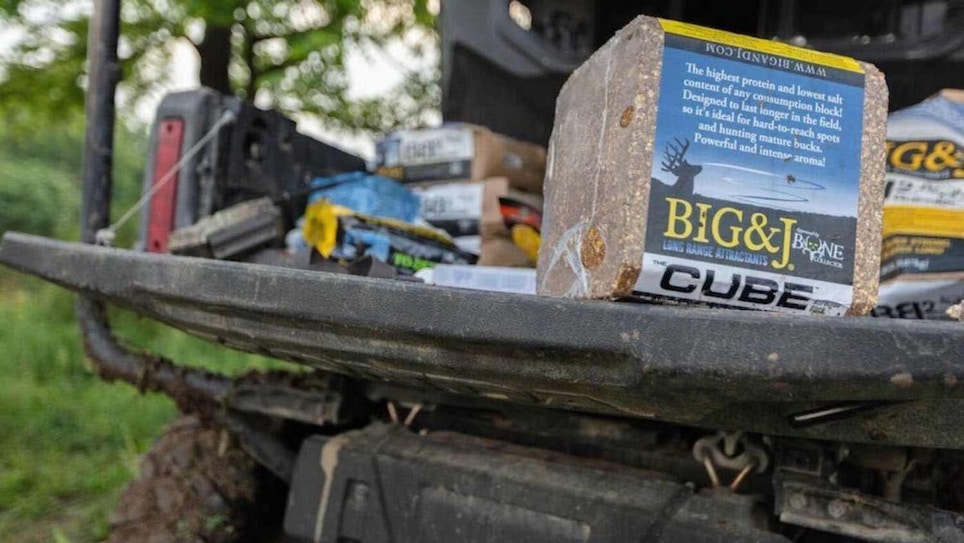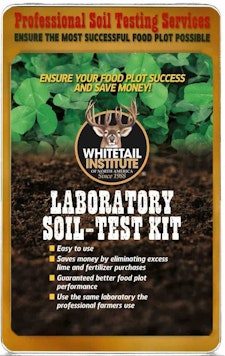Let’s get something straight right off the bat: Food plots and minerals provided by hunters aren’t necessary for whitetail deer to survive. If a piece of property has deer, then they’re finding enough food and minerals to live and reproduce. They could have the best, mediocre or worst food and minerals, but if they’re there, deer will find and use them.
Here’s another truth: Hunters don’t care if the property they hunt has natural food and minerals for deer, because they want to do more. They want to put food plots in open areas or hidey-holes in the woods. They want to create a little kill plot for bow season, or maybe a giant plot like in a magazine photo to offer more food in winter. They want to add mineral blocks or create mineral or salt licks near water sources for deer to use during summer.
All these things are work, but they’re fun work. They’re fun to do. Deer hunters have been creating food plots for more than 50 years, at least. Back in the 1970s, even before I began hunting, I recall my father going off for a weekend or two in summer to plant food plots at deer camp. They were little more than winter wheat and rye, something that would come up in deer season. I killed my first buck, a little forkhorn, with a Winchester .243 while sitting in a ladder stand overlooking a food plot.
Whether your customers are deer hunting in areas they believe need enhancement, or they’re doing the work just because they enjoy it, consider giving them a hand. Stocking food plot seeds and minerals is a way to add extra sales during spring and summer. Here are some of the pros and cons of doing that from someone who experienced it first-hand.
Hands-On Experience
For more than a decade, Bryan Hughes operated Backwater Outdoors on a major four-lane highway just east of Huntsville, Alabama’s largest city. Hughes began his retail odyssey with a small store across the busy highway from where Backwater Outdoors eventually was located. The store was big and roomy, with ample parking and outstanding visibility from the highway.
Hughes sold bows, crossbows, targets, archery accessories, bowfishing bows and gear, had a solid repair business, and an indoor range. He hosted dot shoots at the range. Along with big box chains, the area had two other independent archery shops along with Backwater. All three stores were spread apart enough that everyone had a territory, so to speak, with repeat and loyal customers.
Backwater offered food plot seeds and minerals. Hughes figured out quickly that it was tough sledding trying to compete with chain stores or local feed-and-seed stores that offered special blends. Backwater is closed now, but the pros and cons of selling minerals and seed still hold value.
“If you have a good location without any feed stores or big box stores within an easy drive, you might not have the competition or as much competition,” he said. “I think one of the best things to do is try to figure out some way to set yourself apart with something different than what they sell or, even better, a local brand. You’re not going to beat them on prices when they’re buying in volume.”
As with any retailer, Hughes and his team along with customers would kick around ideas about what was hot, what might sell best in the area, or what was popular. They thought about selling corn in some kind of 24/7 vending machine. Today, hunters in the Southeast can get loads of corn from giant hoppers in some towns.
“We had that idea years ago before it was a thing, like having an ice machine but for corn,” he said, laughing about it now. “We’d be sitting around kicking ideas and that always was one we thought would be a good one. It was, for someone else. They’re definitely easy to see when you drive by one of them.”
While giant hoppers of “deer corn” may not be for everyone, selling minerals and food plot seeds during late winter and spring can make your cash register ring. Powdered minerals need to be put out before summer arrives so rain can dissolve them into the soil. Blocks may not dissolve as easily, but eventually will. Deer will find these man-made licks and return to them during summer when they need a hit, pawing the ground and licking the soil to get the minerals. Locating them near water sources, such as a creek, is beneficial because deer need both for better health.
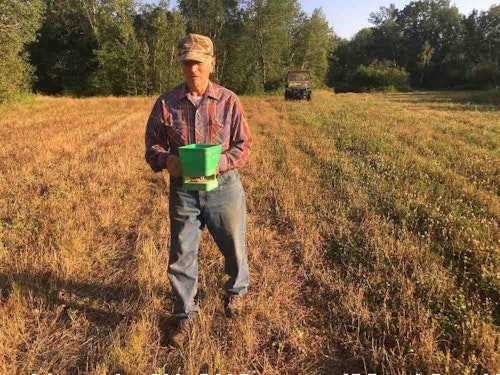
Why Food Plots Matter
Food plots require more work to achieve success. Planning ahead is required to get the best results. Hunters usually have plot locations in mind by spring, if not earlier, if they’re going to plant plots for summer, autumn or winter. Soil tests and any pre-planting soil prep, such as liming or fertilization, should be done prior to planting.
Some of the most popular seeds in commercial blends are alfalfa, clover, rape, oats, rye and wheat. Brassicas are popular for planting during late summer, with deer hammering them, especially after the first frost and during colder temperatures. Radishes and turnips also are popular; deer will nosh on the tops and roots. Check with your sales reps about which blends are best for your area. Stocking the hot or popular blends may be trendy, but if they’re not optimal for your planting zone, then customers won’t be happy.
Sourcing local blends also is a great idea, Hughes says.
“We had a couple of brands that were locally made but they weren’t sold in the big stores,” he said. “It was someone in Alabama making a blend, and they had it in a few independent stores. Customers would ask what we had and we could say it was made in Alabama by people who knew the area. If you’re trying to sell the bigger-name blends, customers probably are not going to buy those from you. They’re going to go to the big chain store to buy them because it’s a volume thing and they will be cheaper there. They know that and you know that. Having local products seemed to be a plus for us.”
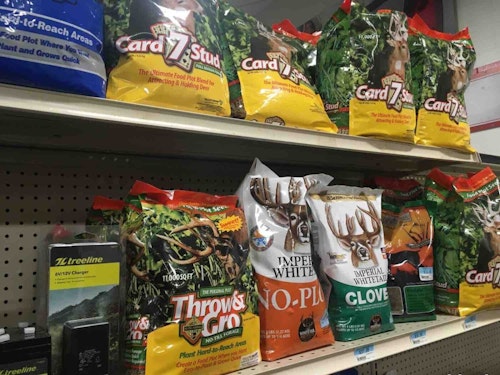
Downsides to Selling Seeds
Having products that don’t sell on your shelves is a bummer, of course, but that’s part of business. With food plot seeds, though, you may pick up a few extra problems that will require more attention if they don’t sell in season.
Even the best bags aren’t immune to the sharp-edged teeth of hungry mice or rats. Sounds gross, of course. No one wants either of those in the store. But it’s a realistic possibility.
“That’s an issue, for sure,” Hughes said. “We tried to keep bagged corn to sell, too, and that was a problem. If you put it on the shelf it was a little harder for them to get to, but mice are pretty persistent. But that’s something you know going in that you’ll probably have to deal with, and you just do your best trying to control them.”
One other downside is that seeds have an optimal period for planting and sprouting. Having bags of unsold seeds for more than a year starts the clock ticking on having to lower prices to get rid of them.
“Some people don’t want older seeds,” Hughes said. “If you have seeds that are a year or two old, and their germination life isn’t optimal anymore, that’s not good. They still may grow, but some people will ask about the age and don’t want older seeds. That’s another issue you run into trying to compete with the bigger stores or the local feed stores, or even ordering online.”
Host Food Plot Seminars
Bring in a local specialist from your state agriculture extension service or some of the seed companies. Order pizzas (keep it simple, cheese, sausage and pepperoni) and have sodas. Have a pot or two of coffee because, well, coffee. Over-plan, of course. Running out of pizza and soda is worse than having too much.
Your expert speaker could touch on what works best in the area and seasonal possibilities. Other possible topics, especially likely to come up in any Q&A session, would be about sizes of food plots, soil testing and preparation, fertilization, weed control and more. Many hunters create square or rectangular food plots because they follow fence rows or boundary lines. Irregularly shaped plots are considered more favorable to help give deer a sense of security.
If you have room in your store to do this, it’s a solid way to get customers in there to see your merchandise and also learn more about food plots. Advertise well and get the word out. Or, possibly, consider a Saturday blowout in your parking lot with tents and a big sale.

Selling Minerals
Whitetails seek and need the best food sources throughout the year, depending on the season and their needs. New growth of these plants is a primary target in spring and summer growing periods. A prime example is a new soybean field, with tender shoots offering ample opportunity for grazing. Another is a downed tree or stump from which new growth is emerging, full of vitamins and minerals. Deer will repeatedly return to nibble on the tender leaves and stems.
Pre-formed mineral blocks, powdered minerals that can be put out, or options such as Trophy Rock all are popular. They’re easy to store and advertise, and they sell well. Deer seek salt and minerals during the summer antler-growing and pregnancy period. Spring is not too early to begin pushing minerals to customers who can get them into the woods in specific locations before summer arrives.
“We always did pretty well with Trophy Rock just because it was pre-packaged in plastic wrap and people could stop to grab a couple pretty easily,” Hughes said. “I think minerals are easier to sell, anyway. A guy could pick up a couple of rocks, or some mineral blocks, and be in and out quickly unless he had something else he wanted to look at or needed. The other thing is we had some minerals that weren’t like the ones in the big box stores.
“I would not sell the same stuff they have at Walmart or the other big stores. It’s just not going to work out as well for you competing against them. Sometimes, too, they sell the less-expensive stuff because they can buy it on volume. I get that. That’s their model, right? But if you consider maybe putting in some specialty products that might cost a little more, that would be something that sets you apart.”
Be sure to check state regulations about use of minerals and supplements so you can inform customers. In some states, hunters can use them on private or leased lands but not on public lands. You may get questions about legalities, or times they can be used during the year. Being able to provide this knowledge is a plus.
Selling food plot seeds and minerals can be a great boost to revenue. If you don’t already sell them, it can bring in new customers. Existing customers may see the addition as a spark for their property. Plan accordingly for storage, think ahead to upcoming growing seasons when ordering, and be prepared for a few new twists as your sales grow.
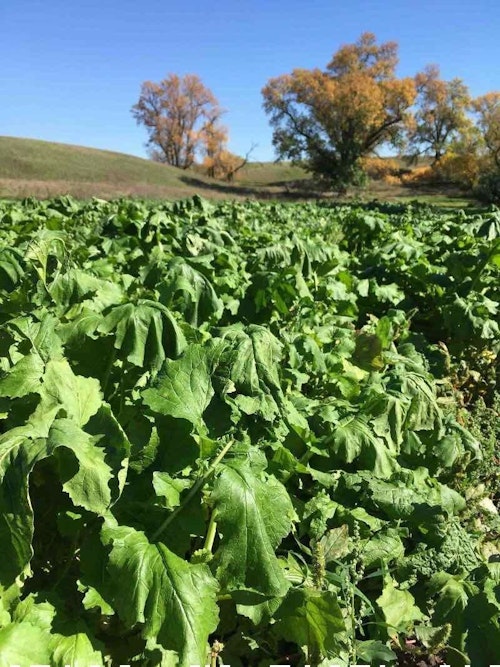
Sidebar: 5 Proven Food Plot Products
Anilogics Crush Plus Alfalfa — This perennial can be planted in spring and autumn, providing deer and other wildlife a buffet for months. The combination of creeping alfalfa, yellow-blossom alfalfa, Ani-Crush white and red clovers, crimson clover and select white clovers offers high protein and ample forage. The blend has seeds with different maturity times to provide consistent forage for months.
Big & J The Cube — High-protein content and a powerful attractant comprise The Cube, combining two things hunters want most. The Cube has more protein than other blocks, which helps bucks and does during summer when nutrition is valuable for antler growth and reproduction. The attractant helps bring them to the site and keep them coming back.
BioLogic Maximum — Many years ago when Mossy Oak’s team hunted in New Zealand, they learned about the country’s nutrient-rich brassicas loved by wildlife on the island. Here in the states, the same nutritional value can be provided to whitetails, along with a large yield. The blend of brassicas mature at different times to provide nutrient-dense forage throughout the life of the food plot. Maximum was developed by the New Zealand commercial venison industry to help with rapid weight gain, health and antler growth.
Lucky Buck Mineral — Lucky Buck Mineral supplements a deer herd’s diet with minerals that not only make them healthier, but also provide the boost bucks need to develop bigger racks. Lucky Buck Mineral was developed with ratios of minerals that deer love, mixed with an ingredient that will limit the amount they want to eat — unlike attractants that include grain or molasses, which cause deer to overeat. For the best results, Lucky Buck Mineral should be used year-round. Just dump the granular powder on a stump, log or even on the ground. It will not be affected by rain or snow.
Whitetail Institute Imperial Whitetail Clover — With a history dating back decades in seed research and successful food plots, Imperial Whitetail Clover is well-known and popular. Imperial Whitetail Clover is genetically designed for deer and contains a high-protein content that is helpful for body and antler growth, and reproduction. It is extremely cold-tolerant, resistant to heat, drought and disease, and is coated with RainBond for seeding survivability.
Sidebar: Food Plot Accessories
If you’re going to add food plot seeds to your store, consider selling these planting accessories:
Chapin GameKeeper 25-pound Handheld Bag Seeder — Bag seeders are super for hunters on a budget or those who want to create small plots. They’re also great to pack into the woods to create little hidey-hole plots. The Chapin bag seeder has a waterproof, zipper-top bag and works with a variety of seeds or granular fertilizers. It has a rear baffle, enclosed gear box, adjustable shoulder strap, application chart on the bottom of the spreader, 25-pound capacity and calibrated flow rate adjuster with easy on-off control.
Moultrie ATV Sprayer with Electronic Feed Gate — The rustproof plastic hopper holds up to 100 pounds and has a tapered design for complete seed unloading. A quick-release system allows for easy detachment when the work is done. It has universal mounting brackets compatible with most ATV models, a hand-held controller, a 12-volt motor, secure lid, large deflection shield and ratchet strap. By adding the Moultrie UTV/ATV/Truck Spreader Conversion Bracket, users can spread seed or corn from an ATV, UTV or truck.
Whitetail Institute Soil Test Kit — Knowing the makeup and needs of the soil where a food plot will be planted is critical for success. Without this knowledge, growth can be hampered or fail. The test kit is easy to use, has simple directions, includes all the items needed, and results can be obtained typically within a week. Then it’s a matter of following the directions to improve the soil before planting. A great addition for your store before the arrival of the spring and summer planting seasons.
